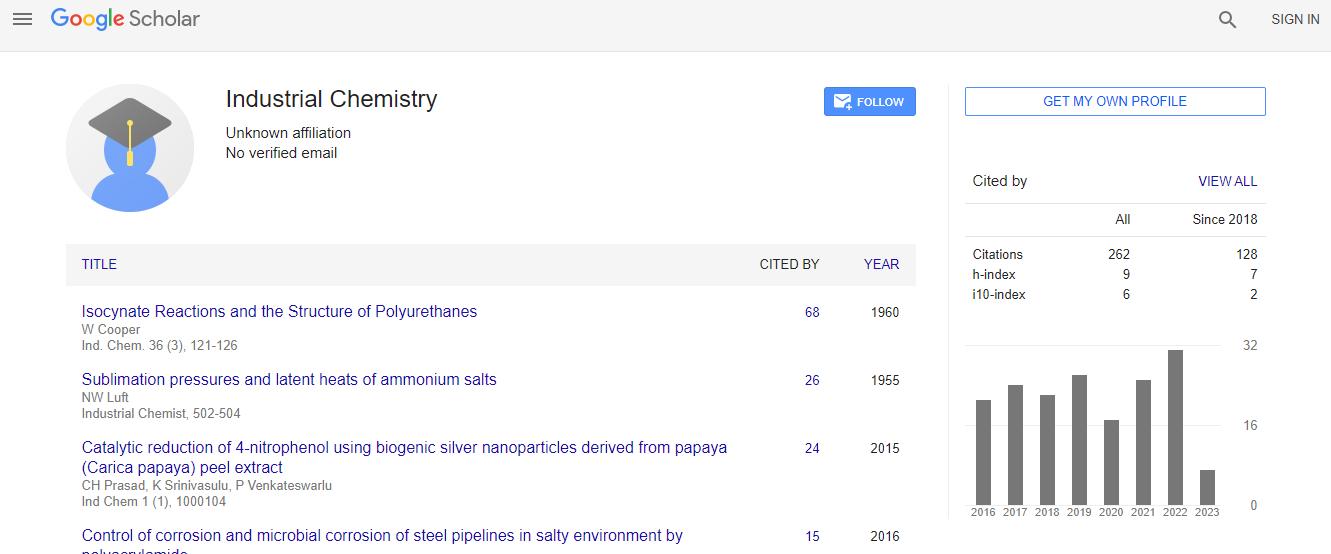Our Group organises 3000+ Global Conferenceseries Events every year across USA, Europe & Asia with support from 1000 more scientific Societies and Publishes 700+ Open Access Journals which contains over 50000 eminent personalities, reputed scientists as editorial board members.
Open Access Journals gaining more Readers and Citations
700 Journals and 15,000,000 Readers Each Journal is getting 25,000+ Readers
Google Scholar citation report
Citations : 262
Industrial Chemistry received 262 citations as per Google Scholar report
Indexed In
- Index Copernicus
- Google Scholar
- RefSeek
- Directory of Research Journal Indexing (DRJI)
- Hamdard University
- EBSCO A-Z
- OCLC- WorldCat
- Scholarsteer
- Geneva Foundation for Medical Education and Research
- Euro Pub
Useful Links
Recommended Journals
Related Subjects
Share This Page
Hydrogen technology for automobiles in the 21st century towards more secure and cleaner environment
2nd World Conference on Industrial Chemistry and Water Treatment
Dhanesh Chandra
University of Nevada, USA
Keynote: Ind Chem
Abstract
Hydrogen is expected to play an important role in future energy scenarios, as it could resolve growing concerns about world��?s energy supply, security, air pollution, and greenhouse gas (GHG) emissions. Hydrogen production from renewable resources can potentially reduce the CO2 emissions. Hydrogen is a non-toxic, clean energy carrier that has high specific energy on a mass basis (e.g., the energy content of 9.5 kg of hydrogen is equivalent to that of 25 kg of gasoline). Worldwide H2 production is ~ 500 billion.m3 annually with ~6.5 EJ (1EJ=109 GJ) of energy. The exhaust from the H2 vehicles is water. Early developments (from 1960) were focused on H2-IC engine vehicles. In 2001, BMW introduced H2-IC engine vehicles. Significant advancements in fuel cell technologies and initiatives offered by the US DOE, world-wide governmental agencies, and industries led to the development of prototypes H2-fuel cell electric automobiles. In the last 10-15 years many auto manufacturers, including Toyota, Honda, Hyundai, Ford, General Motors, Daimler Chrysler and others have developed fuel cell vehicles, some are already becoming commercial. Many countries are installing hydrogen fueling stations but they are relatively few clustered around big, highly populated cities. Low pressure, solid state metal hydrides, such as LaNi4.8Sn0.2, have already been developed for space applications, but they are very heavy and have low gravimetric hydrogen density of ~2 wt.% for vehicular applications. Light weight and low pressure (LP) complex hydrides, such as Mg(BH4)2, Li2NH-LiNH2 and other light weight systems with ~10 to 18 wt.% H capacity are still in developmental stages. Non withstanding the LP solid state systems, Toyota and other manufacturers started using high pressure (~700 bar) H2, carbon fiber composite, cylinders which appear to be functional in the latest vehicles under normal operations. The H2 based vehicular technological developments, and challenges associated with this technology will be presented.Biography
Dhanesh Chandra is a Foundation Professor of Materials Science and Engineering in the College of Engineering at the University of Nevada Reno, USA. He has over 100 scientific publications and is a Member of Hydrogen IEA-Task 32. He wrote a book chapter: Intermetallics for Hydrogen Storage edited by G Walker, Woodhead Publishing (2008).
Email: dchandra@unr.edu

 Spanish
Spanish  Chinese
Chinese  Russian
Russian  German
German  French
French  Japanese
Japanese  Portuguese
Portuguese  Hindi
Hindi 